This post may contain Affiliate Links. Please see my Disclaimer for more details.
With the holidays quickly approaching, it’s almost turkey season. Maybe you’ve been preparing Thanksgiving dinners for decades or maybe you’ve never roasted a turkey in your life. Whatever the case may be, it’s never a bad idea to brush up on your cooking skills.
Here are a few sides to serve with your turkey: 5-Minute Turkey Gravy, Cajun Dirty Rice, Garlic Mashed Potatoes, Southern Green Beans, Corn Pudding, and Sweet Potato Pie.
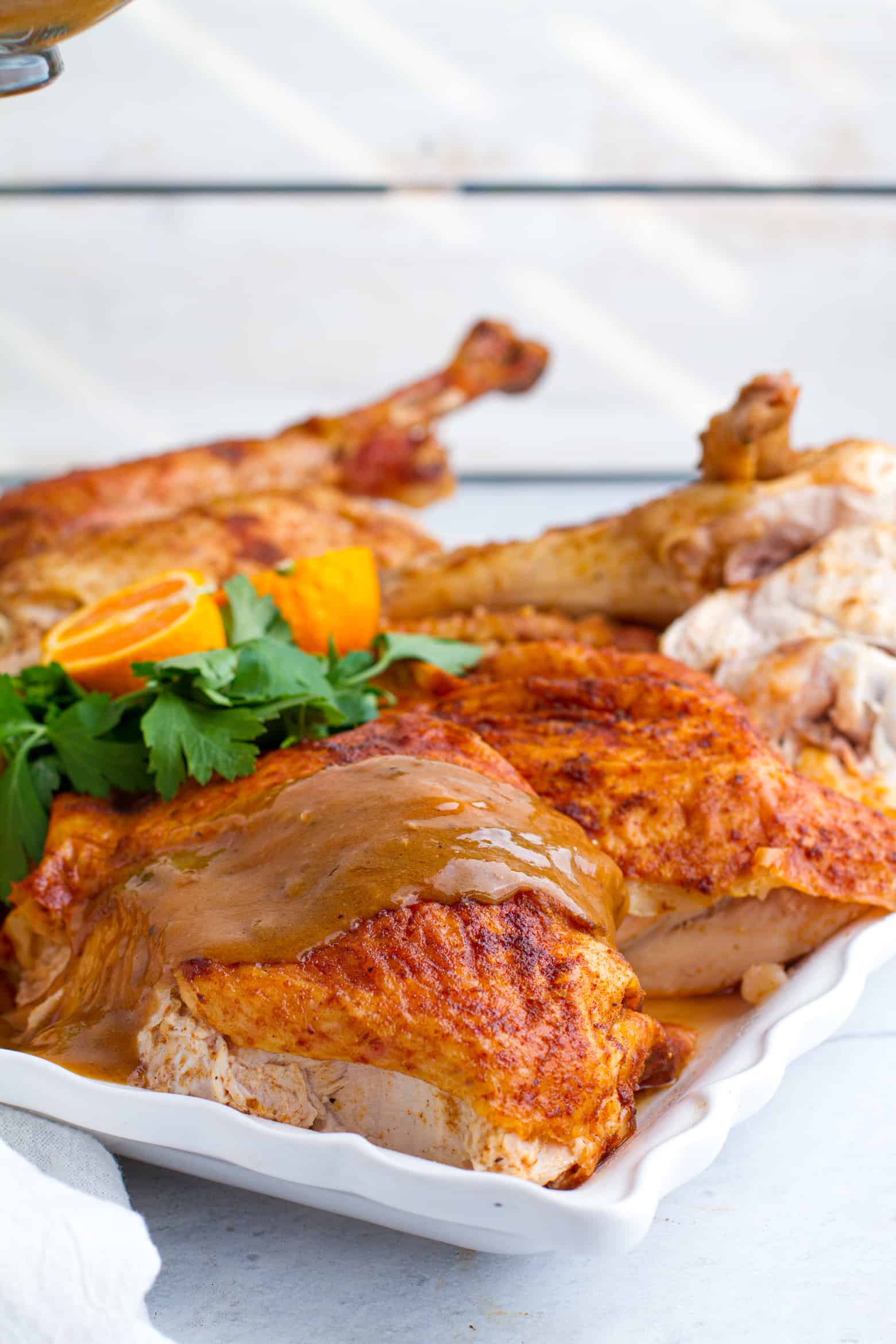
Latest Recipe Video:
Jump to:
- Latest Recipe Video:
- What’s So Special About Turkey?
- What Size Turkey to Buy?
- How to Safely Thaw a Frozen Turkey
- Popular Methods for Cooking Turkey
- How to Roast a Turkey
- Should I Stuff My Turkey?
- Roasting Time for an Unstuffed Turkey:
- Roasting Time for a Stuffed Turkey:
- When is it Done?
- What to Serve With Roasted Turkey
- Turkey Roasting Tips
- 📖 Recipe
In this guide to how to roast a turkey, I will be walking you through every step of the process. From picking the perfect bird to the best ways to serve roasted turkey, this thorough guide will provide you with everything you need, just in time for the holiday season. Now, let’s get right into it.
What’s So Special About Turkey?
For starters, turkey is the star of the show at every Thanksgiving dinner in the country. Unless, of course, you’re vegan, in which case I’m sorry. Many historians believe that the pilgrims did enjoy turkey at the very first Thanksgiving. Turkey is also viewed as a sign of abundance, acting as a symbol of all we have to be thankful for.
In the United States alone, millions of turkeys are consumed every holiday season. Sure, I love my fair share of cornbread dressing, mac and cheese, and sweet potato pie. But nothing says ‘Happy Thanksgiving’ quite like a beautifully roasted turkey on a massive platter. The holiday simply wouldn’t be the same without this iconic symbol of thanks.
What Size Turkey to Buy?
When selecting a turkey to buy at the grocery store, the size matters. Trust me. The last thing you want is to spend an afternoon in the kitchen making the perfect turkey, only to realize that there isn’t enough of it to serve everyone. I don’t know about you, but that would not go over very well in my house.
In order to avoid a house full of angry cousins, in-laws, and grandparents, it’s essential to buy a big enough turkey to feed your crew. As a general rule, I make sure to allow for ¾ to 1 pound per person. This accounts for the bones too. So if you’re feeding a group of 10 people, you should be looking for a 10-pound turkey. However, if the bird is over 12 pounds, each guest should only need ½ to ¾ of a pound, so keep this in mind.
Don’t forget to make room in your fridge before bringing home your turkey! The last thing you want is to get home and realize there’s no space for it. This happened to me once, and I ended up in an at-home version of Chopped, so I didn’t have to waste some food to make room for my bird. The things we do to provide excellent holiday meals for our loved ones, am I right?
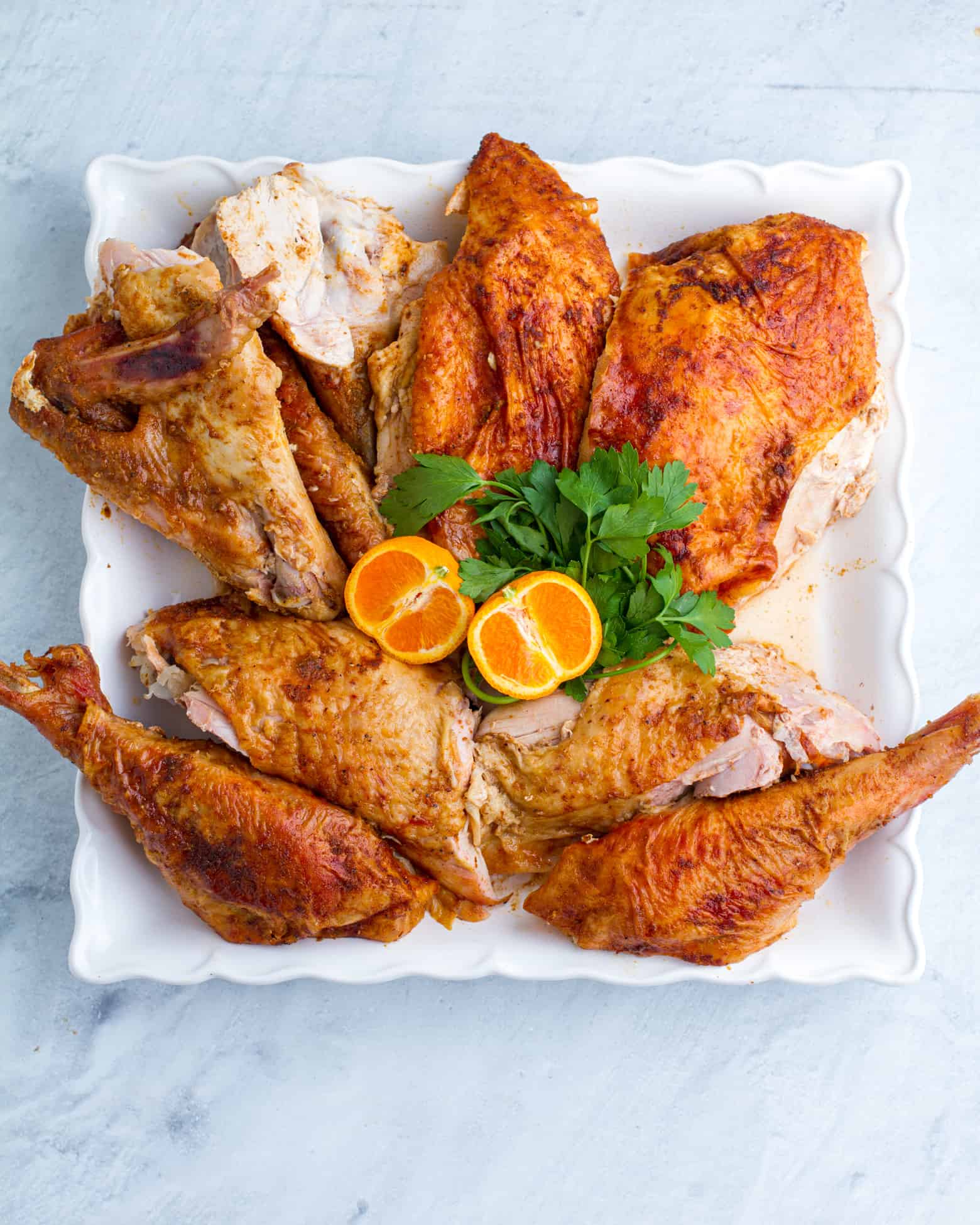
How to Safely Thaw a Frozen Turkey
My preferred method of thawing a frozen turkey is letting it thaw in the refrigerator for 2 days. This is the best and easiest way to get the job done. However, if you don’t have that kind of time, you can put your bird in the sink and run cold water over it for 4 hours or until thawed.
While it may be tempting to run hot water over it to speed up the process, this will slightly cook your turkey, which will wind up messing it up in the long run. Treat your turkey with love!
This turkey thawing time chart is a good rule of thumb:
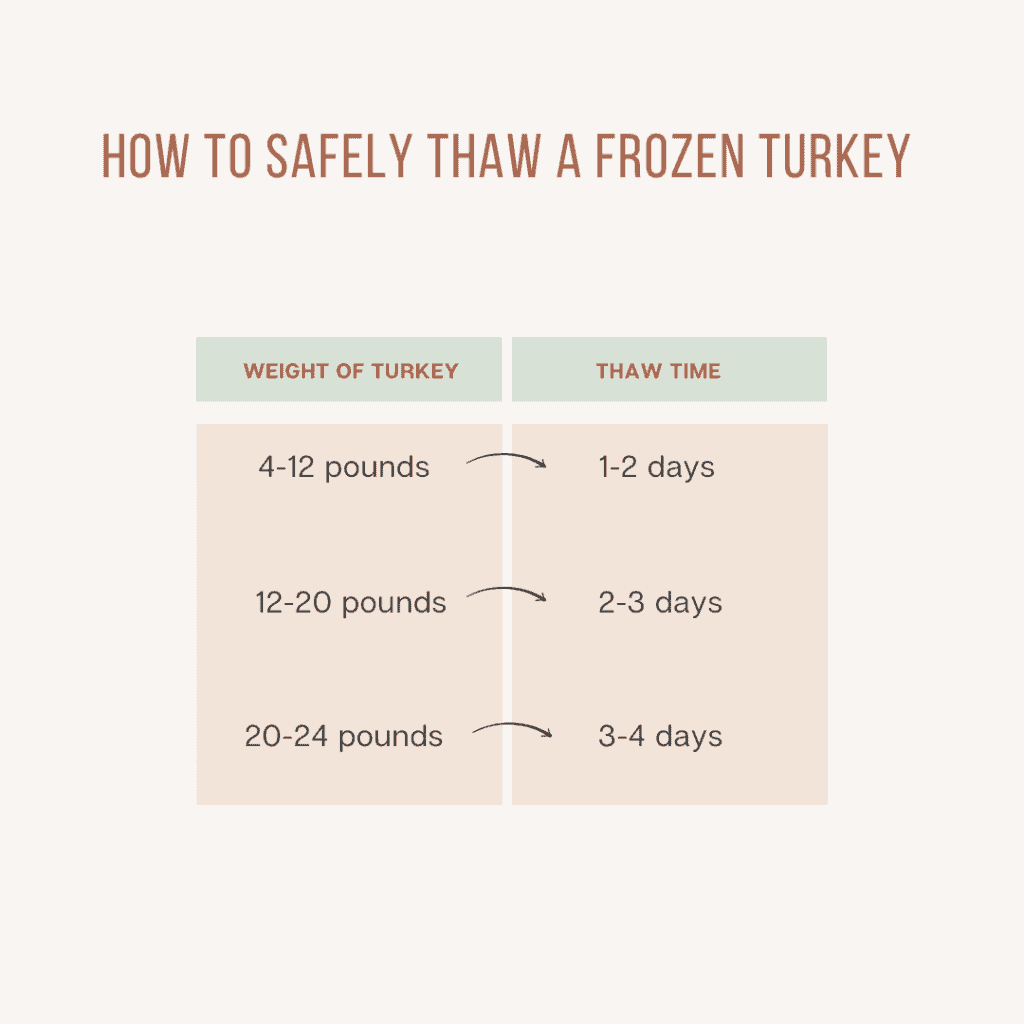
Popular Methods for Cooking Turkey
When it comes to turkey, there is no perfect method. It’s entirely subjective. Some people prefer the classic, and others enjoy dunking their turkey into a deep fryer. Some of the top cooking methods include:
- Roasting
- Frying
- Smoking
- Broiling
- Grilling
I’m pretty confident that I’ve tried just about every turkey cooking method out there. While each method can certainly yield delicious results, I have to say I’m partial to the tried and true roasted turkey. That’s why in this guide, I will be teaching you how to roast the perfect turkey.
How to Roast a Turkey
Through years of hosting Thanksgiving dinners for my family and friends, I can safely say that I’ve perfected my roasted turkey recipe. This method is fool-proof and yields mouth-watering results every single time. As long as you follow these simple steps on how to roast a turkey, you’re guaranteed to impress at the dinner table this year.
First things first, you will need a roasting rack. Placing the turkey on a rack allows for the best air circulation during the roasting process, ensuring that every part of the turkey gets roasted to perfection. You will also need to prepare your seasonings and any kind of stuffing you plan to use. I always try to make sure I use 1 teaspoon of kosher salt for every pound of turkey.
Step 1: Preheat oven to 350°F. Season the cavity of the turkey with 1 tablespoon of Cajun seasoning. Turn the turkey breast side down and brush with melted butter then season evenly with 2 tablespoons of season. Flip over and repeat.
Step 2: Place half of the onions, bell pepper, celery, and garlic inside the turkey, and the other halves in the roasting pan. Place turkey in roasting pan.
Step 3: Most turkeys come with the legs tied together or tucked under the skin, tie legs back up and cover.
Step 4: Bake for 2 ½ hours, remove the cover and pop back in the oven for 30 minutes or until turkey browns. Remove from oven and use an instant-read thermometer and insert into the thighs and make sure it reads 165°F. Cool for 30-45 minutes before serving. You can keep warm by covering it slightly.
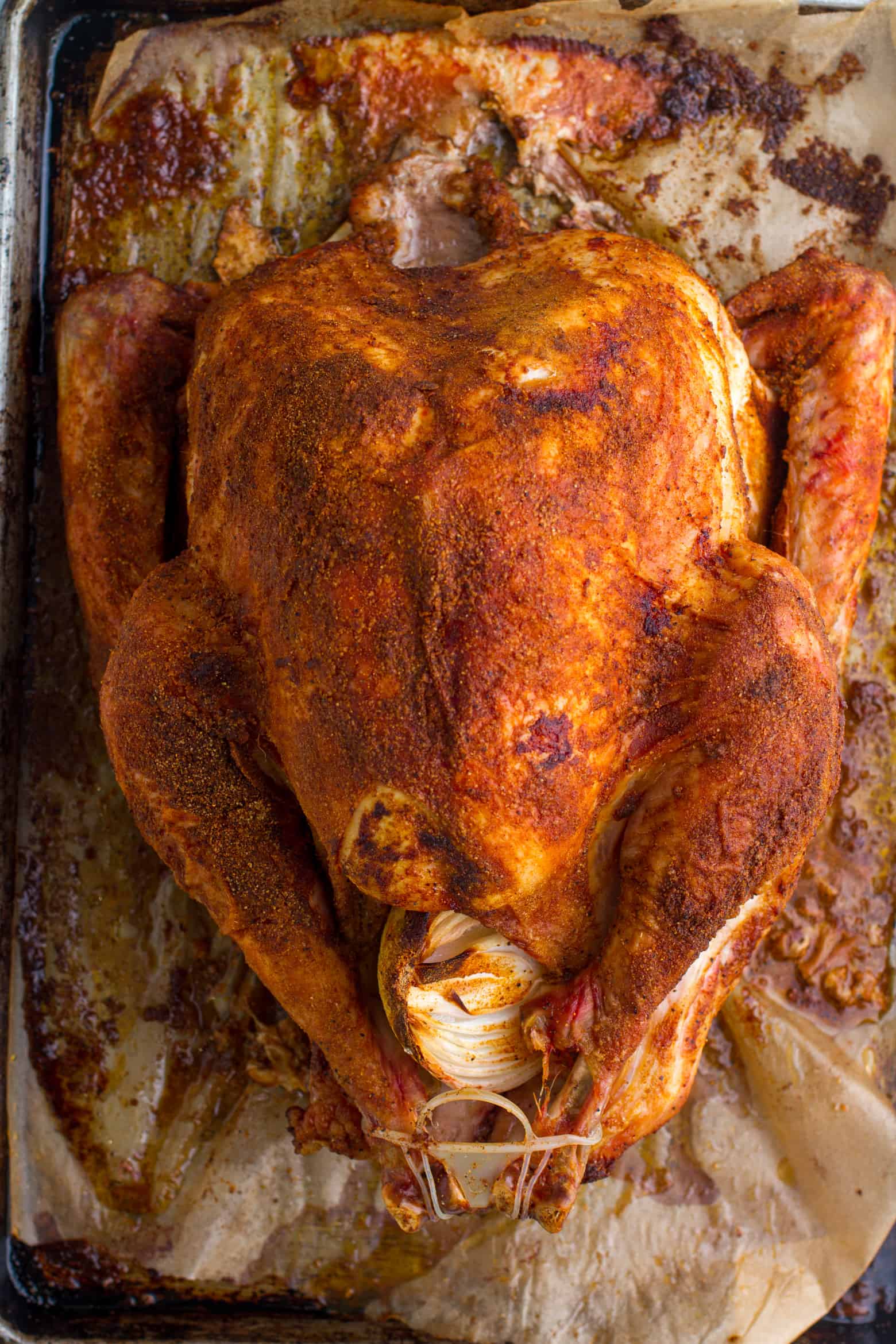
If you don’t have a roasting pan, bake on a foiled-lined baking sheet and add with the legs facing the back, and rotate every hour for even browning.
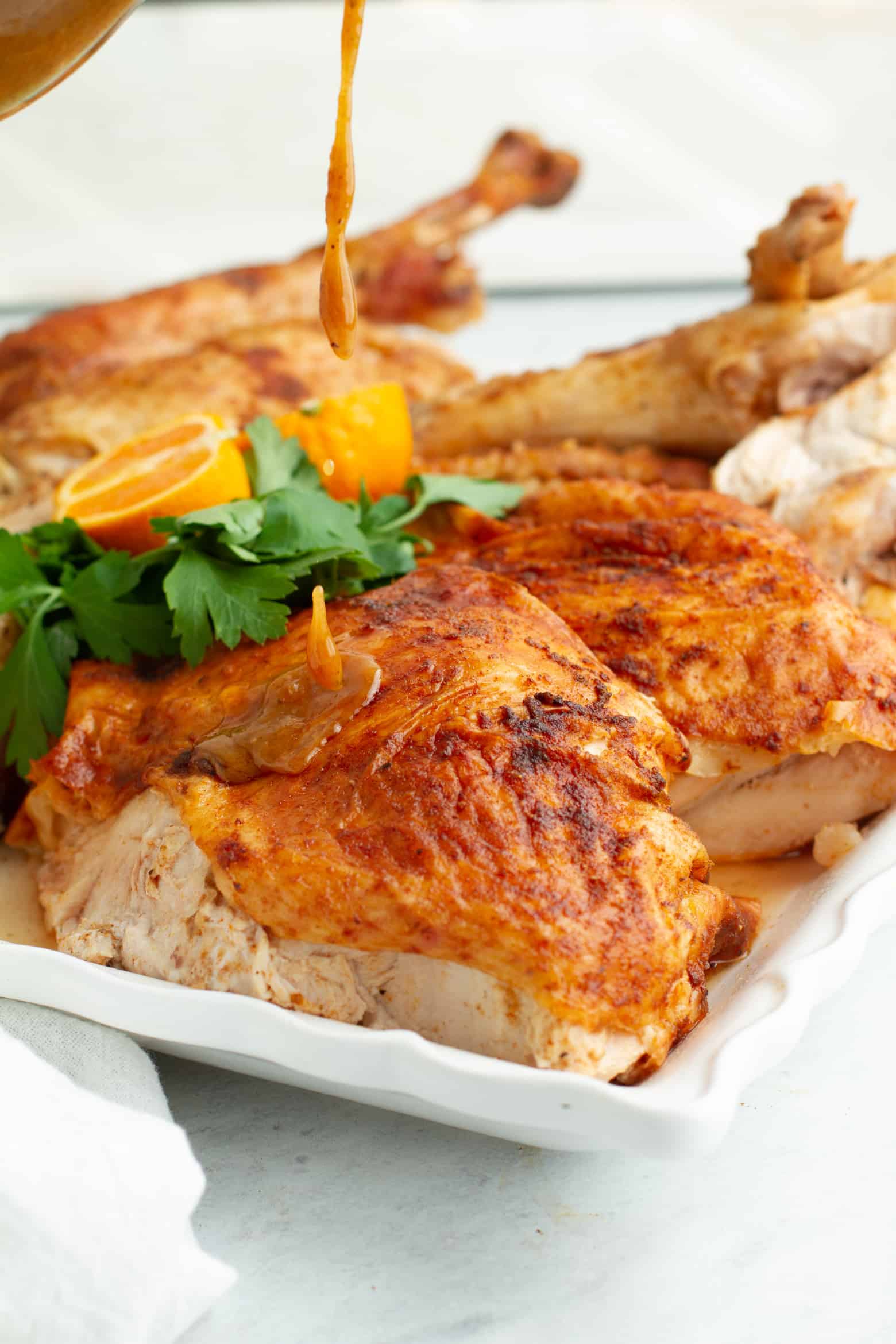
Should I Stuff My Turkey?
The first question to keep in mind before roasting a turkey is stuffing or no stuffing. Neither way is incorrect—it’s just a matter of personal preference. Keep in mind that whichever style you choose will affect the cooking times. Because a stuffed turkey adds more food to cook, it should cook for longer than an unstuffed turkey.
Remember to check the internal temperature of the stuffing as well. When the stuffing temperature has reached 165°F, it’s safe to eat.
Roasting Time for an Unstuffed Turkey:
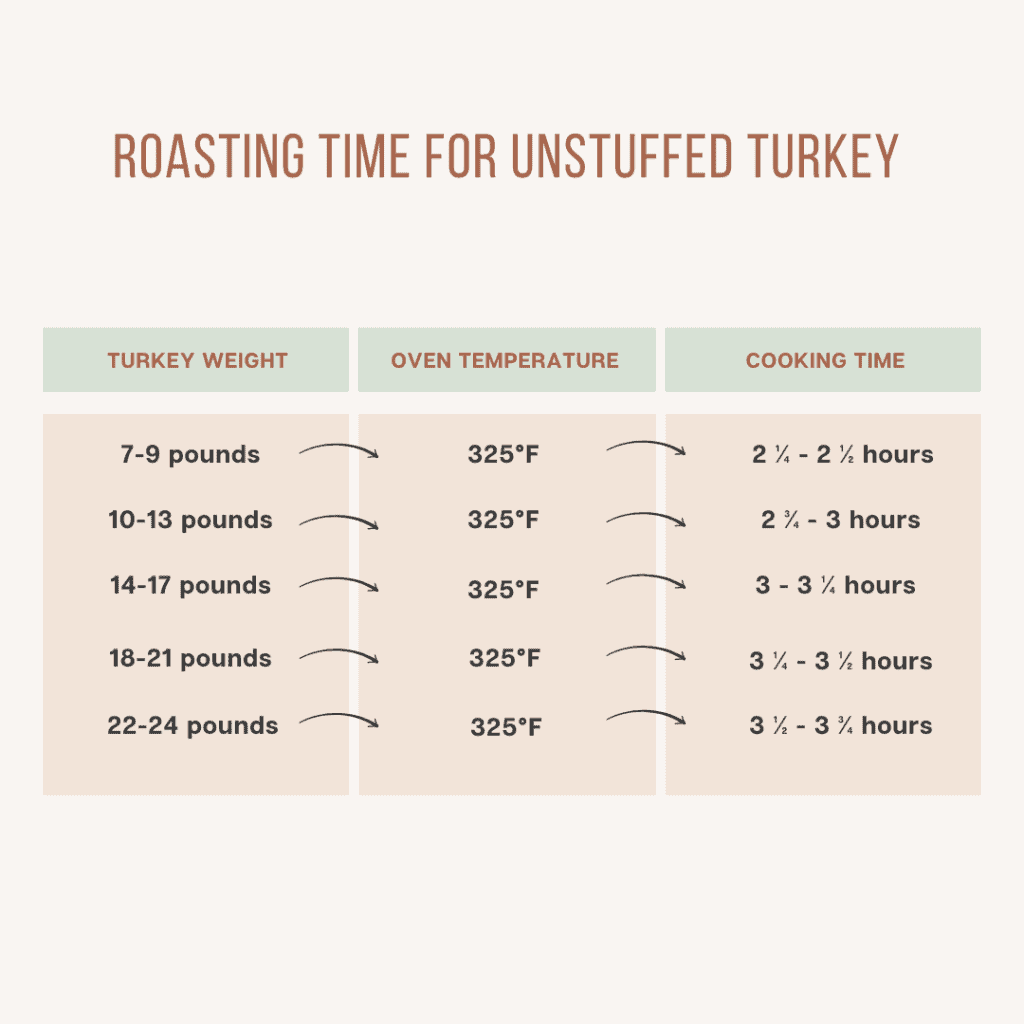
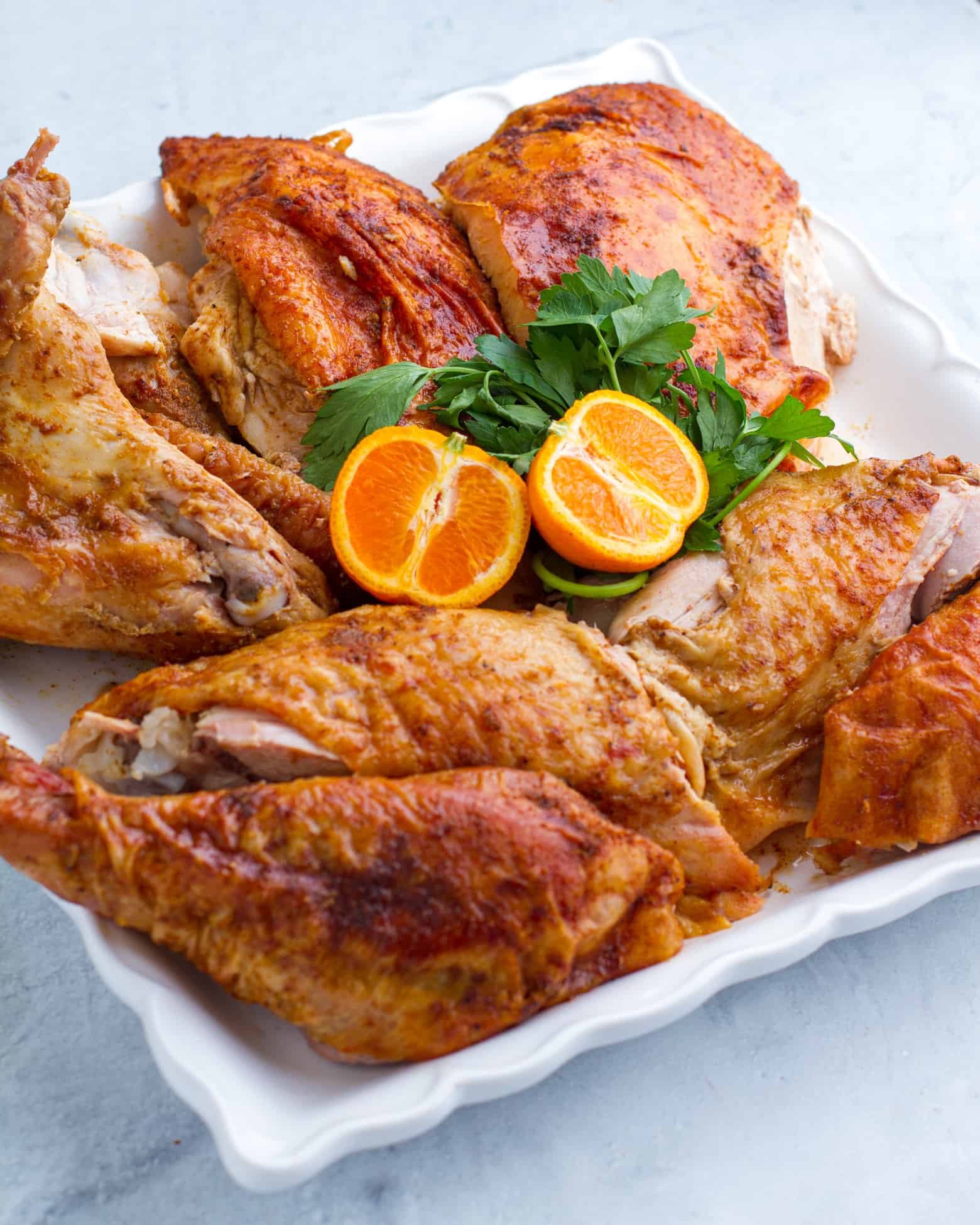
Roasting Time for a Stuffed Turkey:
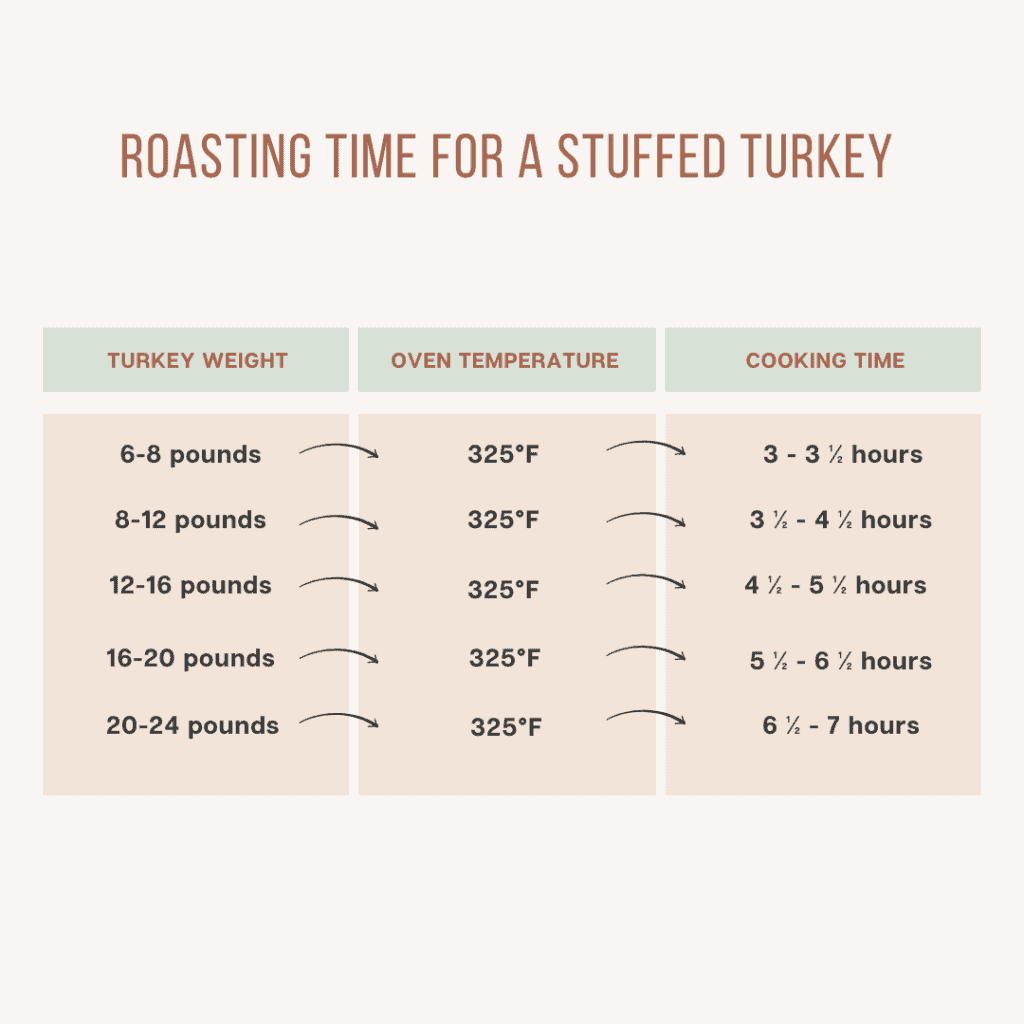
When is it Done?
The last thing anyone wants on Thanksgiving is to be served an undercooked turkey. To avoid ruining the dinner, always check that the juices are not pink before removing the turkey from the oven. If they’re pink, the turkey is not ready. A meat thermometer is an essential tool when roasting a turkey because it lets you confirm that the meat is fully cooked before carving into the turkey.
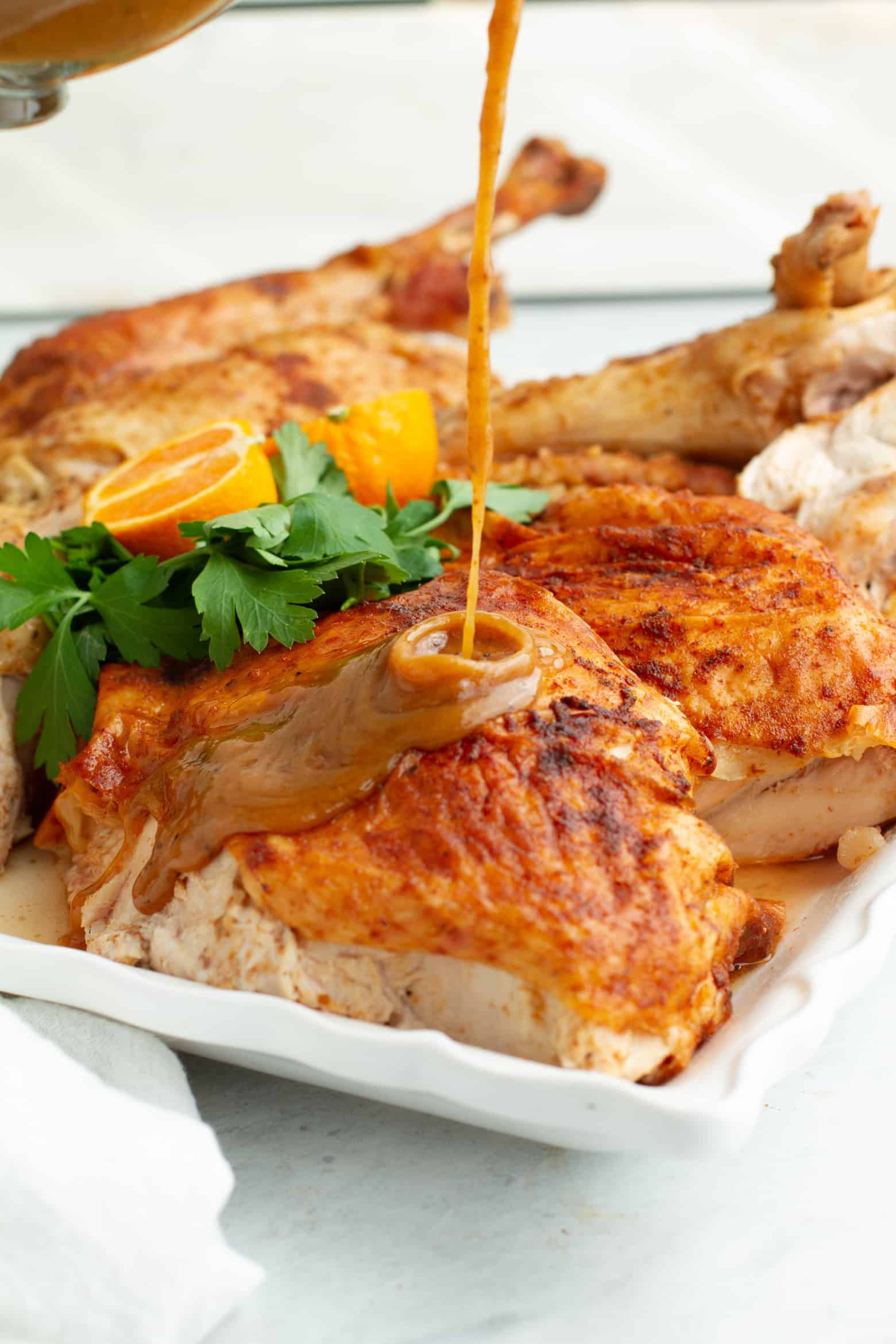
Your roasted turkey is done when the internal temperature of the stuffing has reached 165°F, and the turkey’s internal temperature has reached 180°F in the thigh. As important as checking your turkey’s temperature, it’s equally important to let it rest before diving in because resting the turkey for 20 minutes before carving is essential for getting a nice, juicy turkey.

What to Serve With Roasted Turkey
When it comes to sides to serve with turkey, the options are pretty much endless. I typically opt for Southern comfort food dishes and Thanksgiving classics, but you really can’t go wrong with any of your favorite side dishes. Some of the most common choices include mashed potatoes, green bean casserole, mac and cheese, gravy, and corn.
Not sure what to make? Don’t worry, that’s what I’m here for. Here are some of my favorite dishes to serve with roast turkey:
- Moist Southern Cornbread
- New Orleans Mac n Cheese
- Garlic Chive Cheddar Biscuits
- Cream Cheese Creamed Spinach
- Buttered Mashed Sweet Potatoes
- Creamy Southern Corn Pudding
- Stuffed Bell Peppers
Turkey Roasting Tips
No holiday feast is complete without a turkey. Before you get started, here are some final tips to keep in mind:
- Make sure to choose the right size depending on the number of people you’re serving and thaw the turkey according to its size.
- Before prepping your turkey for the oven, make sure it is fully thawed.
- Cook turkey and stuffing to the proper internal temperature—never skip on food safety—especially when serving a group of hungry people.
- Prepare everything you need ahead of time for an easier cooking process and clean-up.
- Roast your turkey at the corresponding time for its size, but allow for extra time if the turkey is not finished on schedule.
- Cook your side dishes and dessert 1-2 days ahead of time, so you aren’t struggling to get everything done at the last minute.
Whether you have cooked turkey a hundred times or are gearing up to host your very first Thanksgiving dinner, this guide is for you. As long as you follow my tips and guidelines on how to roast a turkey, I guarantee you’re going to wind up with delicious results.
Pair your perfect roast turkey with some of your favorite sides, and get ready to enjoy a meal you will never forget!
📖 Recipe
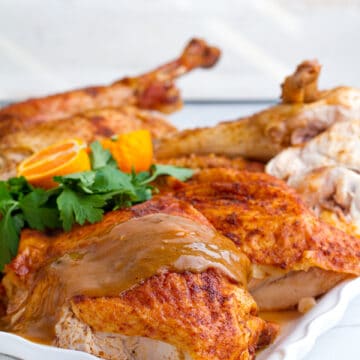
Cajun Roasted Turkey
Ingredients
- 1 12-15 lbs. turkey thawed and dried
- 6 tablespoons Savory Cajun Seasoning
- 4 tablespoons melted unsalted butter
- 1 medium onion halved
- 1 bell pepper halved
- 2 celery stalks chopped large
- 6 garlic cloves
Instructions
- Preheat oven to 350°F. Season the cavity of the turkey with 1 tablespoon of Cajun seasoning. Turn the turkey breast side down and brush with melted butter then season evenly with 2 tablespoons of season. Flip over and repeat.
- Place half of the onions, bell pepper, celery, and garlic inside the turkey, and the other halves in the roasting pan. Place turkey in roasting pan.
- Most turkeys come with the legs tied together or tucked under the skin, tie legs back up and cover.
- Bake for 2 ½ hours, remove the cover and pop back in oven for 30 minutes or until turkey browns. Remove from oven and use an instant read thermometer and insert into the thighs and make sure it reads 165°F. Cool for 30-45 minutes before serving. You can keep warm by covering it slightly.
- If you don’t have a roasting pan, bake on a foiled-lined baking sheet and add with the legs facing the back, and rotate every hour for even browning.


Simmialboyd says
I fix a lot of ur food & it come out so good u show me how to cook I am not a cook but now I do verry well now thank u so much
Kenneth Temple says
This made my day; Your very WELCOME!